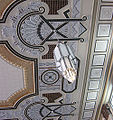
Trinity Metro is a transit agency located in and serving the city of Fort Worth, Texas and its suburbs in surrounding Tarrant County, part of the Dallas–Fort Worth metropolitan area. Since 1983, it was previously known officially as the Fort Worth Transportation Authority (FWTA), and branded itself as The T. As of January 29, 2018 the Board of Directors has voted to rebrand bus services as Trinity Metro, replacing the previous and long standing name. In 2023, the system had a ridership of 5,717,800, or about 20,500 per weekday as of the fourth quarter of 2023.

The Trinity Railway Express (TRE) is a commuter rail service in the Dallas–Fort Worth metroplex, Texas, United States. It was established by an interlocal agreement between Dallas Area Rapid Transit (DART) and Trinity Metro. Each transit authority owns a 50% stake in the joint rail project and contractor Herzog Transit Services operates the line. The TRE began operating in December 1996.

Dallas Union Station, officially Eddie Bernice Johnson Union Station, also known as Dallas Union Terminal, is a large intermodal railroad station in Dallas, Texas. It is the third busiest Amtrak station in Texas, behind Fort Worth Central Station and San Antonio station. It serves DART Light Rail Blue and Red lines, Trinity Railway Express commuter rail and Amtrak intercity rail. It is located on Houston Street, between Wood and Young Streets, in the Reunion district of Downtown Dallas. The structure is a Dallas Landmark and is listed on the National Register of Historic Places.

Fort Worth Central Station is an intermodal transit center in downtown Fort Worth, Texas. It serves two commuter rail lines, two Amtrak intercity rail lines, and Greyhound intercity bus. It also serves as the main transfer center for Trinity Metro, Fort Worth's public bus system.
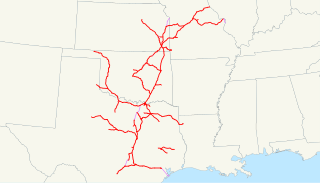
The Missouri–Kansas–Texas Railroad was a Class I railroad company in the United States, with its last headquarters in Dallas, Texas. Established in 1865 under the name Union Pacific Railroad (UP), Southern Branch, it came to serve an extensive rail network in Texas, Oklahoma, Kansas, and Missouri. In 1988, it merged with the Missouri Pacific Railroad; today, it is part of UP.

The Missouri Pacific Railroad, commonly abbreviated as MoPac, was one of the first railroads in the United States west of the Mississippi River. MoPac was a Class I railroad growing from dozens of predecessors and mergers. In 1967, the railroad operated 9,041 miles of road and 13,318 miles of track, not including DK&S, NO&LC, T&P, and its subsidiaries C&EI and Missouri-Illinois.

The St. Louis–San Francisco Railway, commonly known as the "Frisco", was a railroad that operated in the Midwest and South Central United States from 1876 to November 21, 1980. At the end of 1970, it operated 4,547 miles (7,318 km) of road on 6,574 miles (10,580 km) of track, not including subsidiaries Quanah, Acme and Pacific Railway and the Alabama, Tennessee and Northern Railroad; that year, it reported 12,795 million ton-miles of revenue freight and no passengers. It was purchased and absorbed into the Burlington Northern Railroad in 1980. Despite its name, it never came close to San Francisco.

The Texas and Pacific Railway Company was created by federal charter in 1871 with the purpose of building a southern transcontinental railroad between Marshall, Texas, and San Diego, California.
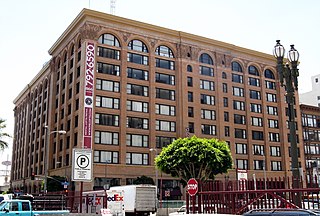
The historic Pacific Electric Building, opened in 1905 in the core of Los Angeles as the main train station for the Pacific Electric Railway, as well as the company's headquarters; Main Street Station served passengers boarding trains for the south and east of Southern California. The building was designed by architect Thornton Fitzhugh. Though not the tallest in Los Angeles, its ten floors enclosed the greatest number of square feet in any building west of Chicago for many decades. Above the train station, covering the lower floors, were five floors of offices; and in the top three was the Jonathan Club, one of the city's leading businessmen's clubs introduced by magnates from the Northeast. After the “Great Merger” of Pacific Electric into Southern Pacific Railroad in 1911, the PE Building became the home of Southern Pacific in Los Angeles. In 1925, a second electric rail hub, the Subway Terminal, was opened near Pershing Square to serve the north and west.

Santa Fe Depot, also known as the Santa Fe Transit Hub, is an Amtrak station located in downtown Oklahoma City, Oklahoma. It is the northern terminus of the Heartland Flyer, a daily train to Fort Worth, Texas.
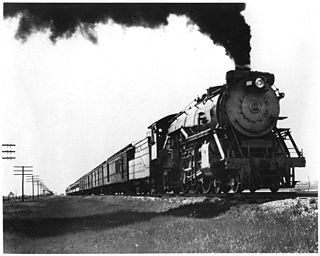
The Fort Worth and Denver Railway, nicknamed "the Denver Road," was a class I American railroad company that operated in the northern part of Texas from 1881 to 1982, and had a profound influence on the early settlement and economic development of the region.

Little Rock Union Station, also known as Mopac Station, is a train station in Little Rock, Arkansas, United States served by Amtrak, the national railroad passenger system.

Texarkana Union Station is a historic train station in the Texarkana metropolitan area serving Amtrak, the United States' national passenger rail system. The Arkansas-Texas border bisects the structure; the eastern part, including the waiting room and ticket office, are in Texarkana, Arkansas, but the western part is in Texarkana, Texas, meaning stopped trains span both states. The station was built in 1928 and was added to the U.S. National Register of Historic Places in 1978. Today it is the second busiest Amtrak station in Arkansas.

Mineola station is a station in Mineola, Texas, United States, currently served by Amtrak's Texas Eagle. The station was originally built in 1906 by the Texas & Pacific Railway and also used by the Missouri Pacific Railroad.

The historic Subway Terminal, now Metro 417, opened in 1925 at 417 South Hill Street near Pershing Square, in the core of Los Angeles as the second, main train station of the Pacific Electric Railway; it served passengers boarding trains for the west and north of Southern California through a mile-long shortcut under Bunker Hill popularly called the "Hollywood Subway," but officially known as the Belmont Tunnel. The station served alongside the Pacific Electric Building at 6th & Main, which opened in 1905 to serve lines to the south and east. The Subway Terminal was designed by Schultze and Weaver in an Italian Renaissance Revival style, and the station itself lay underground below offices of the upper floors, since repurposed into the Metro 417 luxury apartments. When the underground Red Line was built, the new Pershing Square station was cut north under Hill Street alongside the Terminal building, divided from the Subway's east end by just a retaining wall. At its peak in the 20th century, the Subway Terminal served upwards of 20 million passengers a year.

The Santa Fe Terminal Complex is an 18-acre (73,000 m2) complex of historic buildings in the Government District of downtown Dallas, Texas (USA). Constructed in 1924 as the headquarters for the Gulf, Colorado and Santa Fe Railway and the Southwest's largest merchandising center, three of the original four buildings remain today and have been renovated into various uses. Santa Fe Buildings No. 1 and No. 2 were listed in the National Register of Historic Places in 1997, and the buildings are Dallas Landmarks. The Santa Fe Freight Terminal is regarded as one of the chief factors in the development of Dallas commercially.
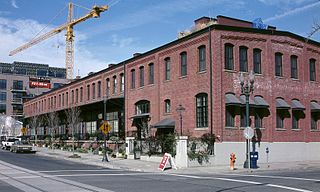
The North Bank Depot Buildings, in central Portland, Oregon, United States, are a pair of buildings formerly used as a freight warehouse and passenger terminal for the Spokane, Portland and Seattle Railway (SP&S). Formed in 1905, the SP&S was commonly known as the North Bank Road during the period in which these buildings were in use. The Portland buildings' passenger facilities were also used by the Oregon Electric Railway after that railway was acquired by the SP&S. Located in what is now known as the Pearl District, the buildings were listed on the National Register of Historic Places in 1996. They were in use by the SP&S and its successor, Burlington Northern Railroad, from 1908 until the 1980s. Only the east building was used as a passenger station, and this usage lasted from 1908 until 1931.

Gulf, Colorado and Santa Fe Railroad Passenger Station is a former passenger train station in Fort Worth, Texas. From 1971 to 2002, it was used as Fort Worth's Amtrak station.

Union Station is a building in Houston, Texas, in the United States. Dedicated on March 2, 1911, and formerly a hub of rail transportation, the building now serves as a cornerstone for Minute Maid Park. It is listed on the National Register of Historic Places, and has since been superseded by Houston's Amtrak station.
The Louisiana Eagle was a long distance night train operated by the Texas and Pacific Railway that from New Orleans to Fort Worth, Texas. The route was distinct in contrast to other routes running west from New Orleans to major Texas cities. It ran northwest-ward from New Orleans to northwest Louisiana and to the major North Texas cities of Dallas and Fort Worth with continuing service to El Paso on the Missouri Pacific's Texas Eagle, whereas other east-west trains from New Orleans into Texas went to the south, to Houston and San Antonio.









